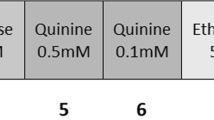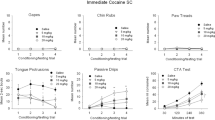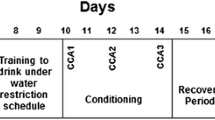Abstract
Male Long Evans rats were obtained at 21 days of age and were housed in either an aggregated (four per double cage) or isolated (one per single cage) condition for 6 weeks. They were then placed on a fluid deprivation schedule that allowed them access to fluids for 20 min daily. This schedule was maintained for the remainder of the experiment. Following habituation, sensitivity to morphine-induced conditioned taste aversion (CTA) was compared in the differentially housed rats. On the 1st day and every 5 days thereafter the rats were presented with a 0.1% solution of sodium saccharin for the 20-min drinking period, followed immediately by an injection of morphine (0, 2.5, 5.0, 10.0, or 20.0 mg/kg). On intervening days they received water as the fluid. No drugs were given on these days. There was no difference in baseline saccharin consumption as a function of housing condition. In comparison with the isolated rats, the grouped animals were more sensitive to the CTA-inducing properties of low doses of morphine. These data strengthen the already existing evidence for the influence of the early housing environment on drug sensitivity and provide additional support for the conclusion that variability in response to a number of drugs of abuse can be reduced by environmental means. Possible mechanisms for the differences between isolation and aggregation housed rats are discussed.
Similar content being viewed by others
References
Adler MW, Bendotti C, Ghezzi D, Samanin R, Valzelli L (1975) Dependence to morphine in differentially housed rats. Psychopharmacology 41:15–18
Alexander BK, Coambs RB, Hadaway PF (1978) The effect of housing and gender on morphine self-administration in rats. Psychopharmacology 58:175–179
Alexander BK, Bayerstein BL, Hadaway PF, Coambs RB (1981) Effect of early and later colony housing on oral ingestion of morphine in rats. Pharmacol Biochem Behav 15:571–576
Deneau GA, Yanagita T, Seevers MH (1969) Self-administration of psychoactive substances by monkeys. Psychopharmacology 16:30–48
Domjan M, Schorr R, Best M (1977) Early environmental influences on conditioned and unconditioned ingestional and locomotor behaviors. Dev Psychobiol 10:499–506
Farber PD, Gorman JE, Reid LD (1976) Morphine injections in the taste aversion paradigm. Physiol Psychol 4:365–368
Goudie AJ (1979) Aversive stimulus properties of drugs. Neuropharmacology 18:971–979
Hadaway PF, Alexander BK, Coambs RB, Beyerstein BL (1979) The effect of housing and gender on preference for morphine-sucrose solutions in rats. Psychopharmacology 66:87–91
Hunt T, Switzman L, Amit Z (1985) Involvement of dopamine in the aversive stimulus properties of cocaine in rats. Pharmacol Biochem Behav 22:945–948
Kostowski W, Czlonkowski A, Rewerski W, Peichoki T (1977) Morphine action in grouped and isolated rats and mice. Psychopharmacology 53:191–193
Marcus R, Kornetsky C (1974) Negative and positive reinforcement thresholds: Effects of morphine. Psychopharmacology 38:1–13
Morgan MJ, Einon DF, Nicholas D (1975) The effects of isolation rearing on behavioral inhibition in the rat. Q J Exp Psychol 27:615–634
Panksepp J, Herman BH, Vilberg T, Bishop P, DeEskinazi FG (1980) Endogenous opioids and social behavior. Neurosci Biobehav Rev 4:473–487
Pilcher CWT (1982) Social crowding differentially modified responding to noxious stimuli. In: Colpaert FC, Slangen JL (eds) Drug discrimination: application in CNS pharmacology. Elsevier, Amsterdam, pp 315–323
Reicher MA, Holman OEW (1977) Location preference and flavor aversion reinforced by amphetamine in rats. Anim Learn Behav 5:343–346
Riley AL, Jacobs WJ, Lolordo VM (1978) Morphine-induced taste aversions: A consideration of parameters. Physiol Psychol 6:96–100
Schenk S, Nawiesniak E (1985) Chronic naltrexone treatment increases the heroin-produced facilitation of self-stimulation. Pharmacol Biochem Behav 22:175–177
Schenk S, Williams T, Coupal A, Shizgal P (1981) A within subject comparison of the effects of morphine on lateral hypothalamic and central gray self-stimulation. Pharmacol Biochem Behav 15:37–41
Schenk S, Britt MD, Atalay J, Charlesson S (1982) Isolation rearing decreases opiate receptor binding in the rat brain. Pharmacol Biochem Behav 16:841–842
Schenk S, Hunt T, Colle L, Amit Z (1983) Isolation vs. grouped housing in rats: Differential effects of low doses of heroin in the place preference paradigm. Life Sci 32:1129–1134
Schenk S, Ellison F, Hunt T, Amit Z (1985) An examination of heroin conditioning in preferred and non-preferred environments and in differentially housed mature and immature rats. Pharmacol Biochem Behav 22:215–220
Schenk S, Hunt T, Malovechko R, Robertson A, Klukowski G, Amit Z (1986) Differential effects of isolation housing on the conditioned place preference produced by cocaine and amphetamine. Pharmacol Biochem Behav (in press)
Sklar LS, Amit Z (1977) Manipulations of catecholamine systems block conditioned taste aversion induced by self-administered drugs. Neuropharmacology 16:649–655
Stewart J, Eikelboom R (1978) Pre-exposure to morphine and the attenuation of conditioned taste aversion in rats. Pharmacol Biochem Behav 9:639–645
Wei E, Loh HH, Way EL (1973) Quantitative aspects of precipitated abstinance in morphine-dependent rats. J Pharmacol Exp Ther 184:398–408
White N, Sklar L, Amit Z (1977) The reinforcing action of morphine and its paradoxical side effect. Psychopharmacology 52:63–66
Author information
Authors and Affiliations
Rights and permissions
About this article
Cite this article
Schenk, S., Hunt, T., Klukowski, G. et al. Isolation housing decreases the effectiveness of morphine in the conditioned taste aversion paradigm. Psychopharmacology 92, 48–51 (1987). https://doi.org/10.1007/BF00215478
Received:
Revised:
Issue Date:
DOI: https://doi.org/10.1007/BF00215478




